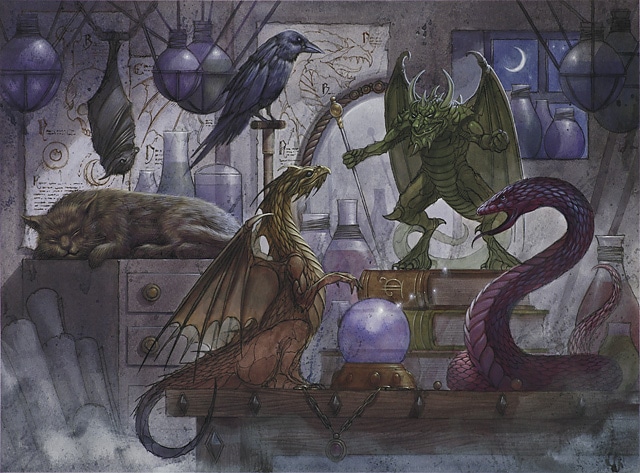Find Familiar is the most sought-after spell in the game. I have seen people take feats instead of an ASI improvement, just to get familiars in 5e. They even have their own miniatures just like monsters and classes cause they are so popular! The reason is that familiars allow a whole new section of movements that ignore many of the restrictions of the action economy in the game. Now if you have read any of my other recent posts, you know action economy is the biggest element in the game. If you did not, then be sure to check out my article that goes into the reasoning behind action economy being so huge here. As such, this post will go over not just helping you choose a familiar, but also ways to use your familiar to ensure successful campaigns.
What Are Familiars In 5e
There are actually two types of familiars. Your standard wizard familiars, and warlock familiars. The two are extremely alike but also vastly different. So different, that they are worthy of their own article. Until then check out this post on DnD Beyond if you are interested in warlock familiars.
A wizard’s familiar is created from the first level ritual spell find familiar. the spell takes an hour to cast and ten gold pieces worth of incense. After that your familiar can be your choice of a bat, cat, crab, frog (toad), hawk, Lizard, Octopus, Owl, Poisonous snake, fish (quipper), rat, raven, Sea Horse, Spider, or Weasel. And this is ignoring any of the options outside the player’s handbook. But do not worry, your familiar can be any one of these as long as you are willing to cast the spell again.
What Can They Do?
Your familiar has a list of actions they can do that is defined in the spell find familiar but for those not wanting to search it I compiled them in the box below.
While your familiar is within 100 feet of you, you can communicate with it telepathically. Additionally, as an action, you can see through your familiar’s eyes and hear what it hears until the start of your next turn, gaining the benefits of any Special Senses that the familiar has. During this time, you are deaf and blind with regard to your own Senses.
As an action, you can temporarily dismiss your familiar. It disappears into a pocket dimension where it awaits your summons. Alternatively, you can dismiss it forever. As an action, while it is temporarily dismissed, you can cause it to reappear in any unoccupied space within 30 feet of you.
You can’t have more than one familiar at a time. If you cast this spell while you already have a familiar, you instead cause it to adopt a new form. Choose one of the forms from the above list. Your familiar transforms into the chosen creature.
Finally, when you Cast a Spell with a range of touch, your familiar can deliver the spell as if it had cast the spell. Your familiar must be within 100 feet of you, and it must use its reaction to deliver the spell when you cast it. If the spell requires an attack roll, you use your attack modifier for the roll.
Also, do your best to remember these so you can think of more ideas as I go over each of the wizard’s familiars. Or just scroll up choice is yours. Anyway, now that we have gone over the generals of what familiars in 5e are, let’s begin the in-depth analysis of choosing your familiars for 5e.
Choosing Your 5e Familiars: Bat (6/10)
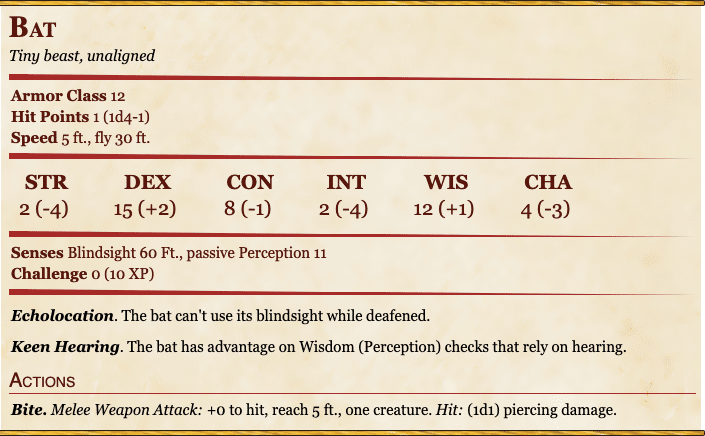
The bat has a few notable traits that make it an excellent familiar for seeing the unseen.
The first and most notable trait is blindsight. Blindsight states “A creature with blindsight can perceive its surroundings without relying on sight, within a specific radius.” In this case, 60 feet.
Now, this is incredibly strong, as invisible creatures can cause havoc among a party for multiple reasons. One, you have no idea where they are. Two, if you do think you know where they are, you roll at disadvantage. Three, all attacks from them are at advantage. This can destroy a party composition as footwork becomes much harder to achieve against an enemy you cannot see. Therefore, by having a familiar that can see the invisible you can overcome a lot of these challenges.
The second benefit to a bat is it having a fly speed. Flight is huge in D&D. So much so, that the Aarakocra, a bird race, was banned in D&D adventurers league because how broken flight was at early levels. Hence, by having a fly speed of 30 ft, your bat can now gather items that are too high to reach or do areal views of a location to see where everyone is, or even just stay off the ground preventing lava damage, or earthquake damage.
The big downside is also its strongest ability, its’ blindsight. Now unlike regular perception, there is a cap on your ability to view the world. Blindsight limits your vision to 60ft. This means, if the enemy is 70 ft away, you will have no clue with your familiar. This can cause serious problems as now you can never be a hundred percent confidence that the area outside of your view is clear of invisible creatures.

Choosing Your Familiars: Cat(5/10)

The Cat, a classic pet but not a classic familiar. These are usually chosen for those in an urban environment due to their commonality, climbing speed, and stealth.
In my opinion, the cat’s greatest strength is their common presence throughout the Dungeons and Dragons world. These make great for being unsuspicious spies in an urban environment so even if they fail their stealth check, for the most part, they won’t be killed or bothered. This means you can plan in accordance toward any urban encounter with how well this blend in with society
The second strength these 5e familiars come with is their mobility. Mobility is vital in the game, especially for familiars. Familiars in 5e only have 1 hit point and low AC. This means that one hit will annihilate your familiar shutting off a large array of actions you can make. Therefore, mobility is key to their survival. And very few familiars in 5e have the mobility that cats possess.
With a 40 ft movement speed and 30ft climbing speed, cats can move faster than most humans and climb as quickly as other animals. Which brings us to their uses. The cat familiars in 5e can reach any vantage point desired while still blending in and having the movement speed to get there faster than most. This translates to you winning in scenarios that require fast movement and certain locations.
Now you might be thinking, “why only a 5 then?” Well, it’s because outside of commonality and speed there are few other things that make a cat exceptional as a familiar in 5e. Even then, other familiars are stronger choices then this because they do these things better. In conclusion, these are great to blend in with good mobility to ensure their survival in an urban environment.
Choosing Your 5e Familiars: Crab (3/10)

Low movement, low perception, weak stealth, and less blindsight than a bat. There are very few reasons to choose this familiar unless you need a familiar that can survive on both land and water.
A crab is one of the weakest familiars in 5e. I see very few reasons why you would choose this one. The only real advantage you gain from this option is the ability to use them in underwater missions and land missions. In fact, there are very few familiar in 5e that can do both. The price you pay for this though is steep.
First, you do not need a familiar with both swim and movement, as familiars can change to a different animal with 1 hour and ten gold pieces of incense. Therefore, greatly weakening that ability.
The second price you pay is you lose 10 feet of movement for both on land and on sea. This is debilitating for movement which means it will take longer for your familiar to explore an area than before or reach their destination.
The last drawback is a lack of sight. Sight is one of the biggest skills in the game. So, why they may be able to see invisible creatures, it is only up to 30 feet. Meaning crabs lose a large radius of sight that would be extremely useful in exploring, searching, or even just seeing invisible creatures.
In conclusion, the price to have crab familiars in 5e are steep. The only reason why I would choose them is for roleplay reasons, or because I believe I will need them in both land and water without the time nor money to change them to a different animal.
Choosing Your Familiars: Frog (4.5/10)

The frog, the only other familiar in 5e that has both a swim speed and movement speed. Yet, the price you pay is so much less than a crab.
There are three good advantages to a frog familiar. The first is that a frog has normal perception meaning it can see past 30ft, unlike the crab. The second is it has Darkvision. This is extremely useful for cave exploring since many areas especially at night, do not have light. Therefore, frogs can see both afar during the day, but also able to see at night.
The third advantage is having a swimming speed and the ability, standing leap. While not as good as a climbing or flying speed, standing leap is the next best thing. With this frog familiars in 5e can still reach areas that are further away even jump over 10 ft drops to reach their destination. So, while situational, the frog still has some mad hops when it comes to reaching another area.
The downsides though are still an issue with the frog. For example, they too suffer from a lack of mobility that comes with having both a swim and movement speed. The second is their darkvision is not as strong as blindsight and still limited to 30 feet. And finally, their abilities are far too niche to be useful in every situation. This said if you plan on being in a cave that has both air and water. Then I would suggest a frog as an option unless you wish to spend the time and resources to keep switching familiars.
Choosing Your 5e Familiars: Hawk (8.5/10)
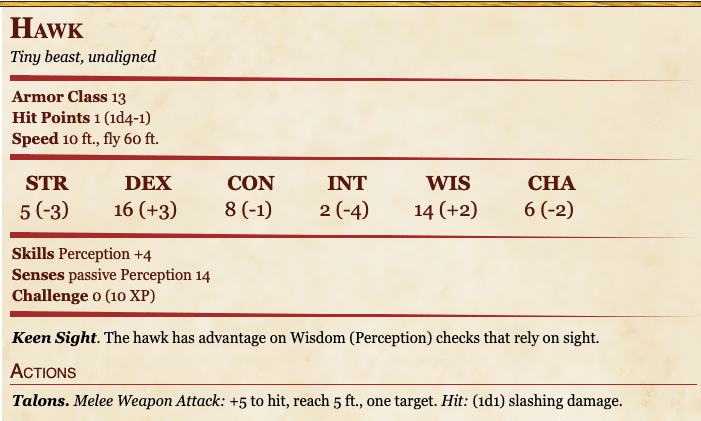
The hawk sports a good perception, decent AC, and a high flight speed that really makes them a solid choice for anyone.
The first thing to pay attention to with the hawk is their perception. With a +4 to perception checks and the ability to do aerial views, the hawk already gains a competitive advantage over most other creatures when it comes to sight. However, the hawk familiars for 5e don’t stop there. They also have advantage on all sight-based perception checks. What does this equivalate to? Well if you have seen my advantage and disadvantage article going over this in detail, you will know this roughly equals a +5 to perception checks. This means you effectively have a +9 to perception checks. So yeah, the hawks have a really strong perception.
The second notable trait is their high flight speed. I have already touched upon that earlier with the bat familiars in 5e, so I will keep it brief. What this flight does, is not just increase mobility, but also synergizes extremely well with their high perception. Aerial views are by far the strongest way to look at a situation (for both real-world and D&D world). Hence, by having a flying creature able to give you a view like that and have a strong chance of rolling a high perception, very few familiars can provide this superiority for you. Not even the bat since it can only see within 60 feet.
There are no real disadvantages to this familiar, except that they stand out. A tamed hawk is not an everyday thing, especially in a city. So, if they fail their stealth check, there is a good chance that your DM will shoot it, or people will notice it and get rid of it.
Choosing Your Familiars: Lizard (2/10)

If you love your lizard familiar, good for you. They can be great for roleplay but very few other things would ever call for a lizard to be your familiar in 5e.
They do have darkvision, a climbing speed, and are inconspicuous for the most part. All of which has been touched on by other familiars so far and why those are great abilities to have for familiars in 5e.
Nonetheless, in every single one of these aspects, other familiars do the job better and have more benefits. Their darkvison is limited to 30 feet which is about average for many of the familiars in 5e, but they only have a movement and climbing speed of 20 feet. Meaning they lack severely in mobility, especially when other creatures without climbing speed can make an athletic check to climb as well. Finally, they might not stick out and can hide easily, but they have a +0 to stealth so not very stealthy. And, when you are found most thugs will kill lizards as they see them akin to bugs.
If I haven’t dissuaded you enough, let’s take a look at perception. They have a perception of -1. Therefore, if you even did succeed your stealth check to get somewhere. Your perception roll has a minus one to it which is equivalent to increasing the difficulty by an additional 5%.
I will be honest the only reason I have not made this a one out of ten is that it still can function, can be fun for roleplay reasons, and there was a story of someone besting a dungeon with the lizard familiars in 5e. That said, other than that, I see very little to waste ten gold to have a lizard familiar.
Choosing Your 5e Familiars: Octopus (9/10)

So, I know meta is used very rarely in D&D, but this is the meta for underwater campaigns. The amount of uses octopus familiars in 5e have is insane. Not only that, but they are extremely good at their job. They sport great stealth, decent perception, and even has an attack they can use even while being a familiar. Let’s take a look.
So, their strengths, I already gushed about them a little bit but allow me to go into detail. The first thing to look at with the octopus familiars for 5e, is stealth. The octopus sports a stealth of +4. Decent enough, but they also have advantage when underwater. Making them function much like the hawk with its’ perception and granting them an effective +9 to stealth. Increasing your chances by roughly 45% in case you were wondering.
Now, once you are hidden, you will need to roll a perception check for your familiar to see what they see. Not near as strong as the hawks, but it still gains a +2 to the roll which can be huge in a roll. Combine that with darkvision, and your general perception checks are covered in regard to the basic calls.
The final thing I want to note about them is their ability “Ink Cloud”. It is not considered an attack, but an ability. Therefore, if your familiar gets in danger and needs to escape they can use this ability to block their vision and dash out of there. Now they still have a chance to hit them, but it is at disadvantage. The real strength comes from doing that against enemies targeting you though. Block their vision, have them to use their reaction on your familiar, then escape yourself or try and kill them. Choice is yours.
Choosing Your Familiars: Owl (10/10)

I give you the most meta of meta familiars in 5e. With extremely high mobility and solid skills all around, the owl familiars in 5e are by far the strongest for both in combat and out of combat. In truth, the hawk actually outperforms the owl in everything but darkvison. But there are two traits in the owl that make them stronger than any other familiar.
“Flyby” the strongest of all the traits familiars in 5e have. The biggest concern with familiars is that they die easily and once they are dead; it takes some time to gain access to them again. With flyby, your familiar now no longer provokes opportunity attacks. So, you want to cast a deadly touch spell with your familiar? Go ahead as he won’t die. Want to help out your comrades with the help action? Send your familiar in there as you both will stay safe. The ability combined with 60 feet of flying speed creates an incredibly strong combo guaranteeing you strong combat control.
The second ability that sets the owl familiars apart is their darkvision. Most familiars only have darkvison out to 30 feet, and as such struggle seeing past that. The Owl though has darkvison equal to the drow, 120 feet. This makes them fantastic at their job to see both day and night. Moreover, when you combine this with their keen hearing/sight, they now have a +3 to perception and advantage on sight putting them only one point behind the hawk familiars for 5e.
Lastly, why not always able to work, invisible creatures can still be located via sound and smell. This means your owl familiar still has a chance to detect their presence with their keen hearing and at advantage too. Making them strong for mobility and scouting.
Choosing Your Familiar: Poisonous Snake(3.5/10)

Ah, the poisonous snake. Terrifying to most everyone but the Yuan-Ti. That said, boy, they are terrible. Yet they still have some uses that make them a decent choice when used creatively. Let’s just get into them, shall we?
Finally, a creature that can move 30 feet on both land and water! But what is this? They have no hold breath or amphibious ability? Which means they can only remain on the surface of the water. Useful I guess if you need them to cross a river but useless if you need them for underwater campaigns.
The second ability is blindsight. As mentioned before a useful ability for seeing the invisible which seems like a plus, however, it is restricted to ten feet. So, if you think you can find the invisible creatures in a ten-foot radius it is still a solid plus.
The real benefit of this familiar though comes with it being poisonous. A Wizards familiar cannot attack in D&D 5e. Making the poisonous part of the snake look useless at first. Yet, it actually has incredible use, if you have the equipment and time.
You see, you can actually be a poison farmer with the snake familiars in 5e. Spend some downtime days and collect as many vials of poison as your DM will allow. Then you have two options, sell it for a profit, or use it to bolster your weapons. The choice becomes yours, but the benefit of this familiar during your downtime days can be great for planning and implementing strategies. In conclusion, why, scouting and mobility are not great, the downtime usage is.
Choosing Your 5e Familiars: Quipper (5.5/10)
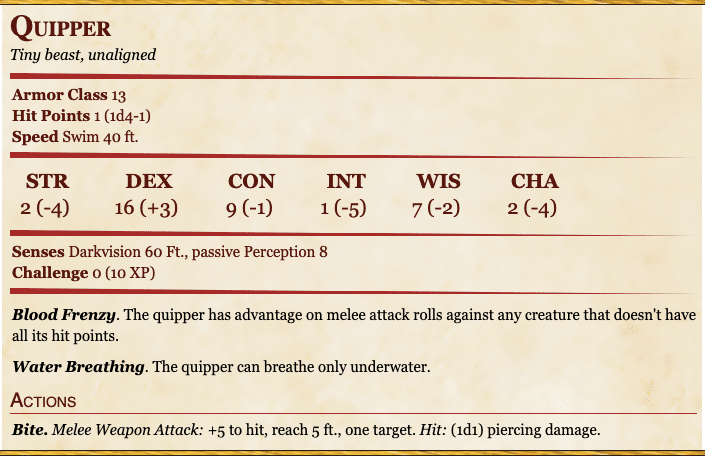
If you are combat-focused in an underwater campaign, then quippers become a great choice for you. The Quipper familiars in 5e are designed for combat but are weak when it comes to perception. Therefore, you should definitely pay attention to what their strengths and weaknesses are.
The strength of the Quipper is combat, and here is why. Quippers have one of the highest AC for 5e familiars. In fact, theirs is higher than most wizards and sorcerers before magic. While not a huge AC it still increases the chances of surviving from enemies attacking them. The second boost is 40-feet movement speed. Great for being able to hang out or reach your checkpoints in quick succession.
Then comes their strongest trait “Blood Frenzy”. Familiars cannot attack I mentioned that earlier in regard to the octopus. However, they can deliver touch spell attacks from their master. This means they themselves cannot attack, but you can attack through them. This synergizes well with their blood frenzy trait as they can cause touch spell attacks to be rolled at advantage. Securing your chances of landing an effective hit.
Now it is time to take a look at their downsides. The most notable trait is a -2 perception. Want to see if there is anything of notice around? Good luck as a -2 increases that difficulty level significantly. Need to make a DC 15 perception check. Well, now it is a DC 17 basically. Hence, if you want them to scout you have better options like the octopus familiars or the frog familiars in 5e.
Choosing Your Familiars: Rat (2/10)

I think the best way to compare this familiar is to compare it to the lizards familiar in 5e. As both functions very similar and lack a lot of strengths.
In terms of mobility, the lizard wins. The reason is that they have a pre-built climbing speed, meaning you do not have to make a check to climb stuff.
That said, a lizard has a -1 to perception while the rat has a flat roll. Nothing too stellar for either one but I would much rather have a flat roll then a negative when I need to roll. Especially if the familiars play the role of a scout more often than not. Couple this with they both have exactly 30 feet of darkvision, and the rat familiars in 5e have advantage on smell perception checks, the rat makes for a better scout.
Finally, a rat might function a little better in a city than a lizard as in the poor districts, they are probably going to be pretty common. That said, a lizard would potentially stand out slightly more but be ignored by almost all the same. Therefore, the choice is really yours. I suggest choosing the one that matches you better for roleplay reasons.
Choosing Your 5e Familiars: Raven (6.5/10)
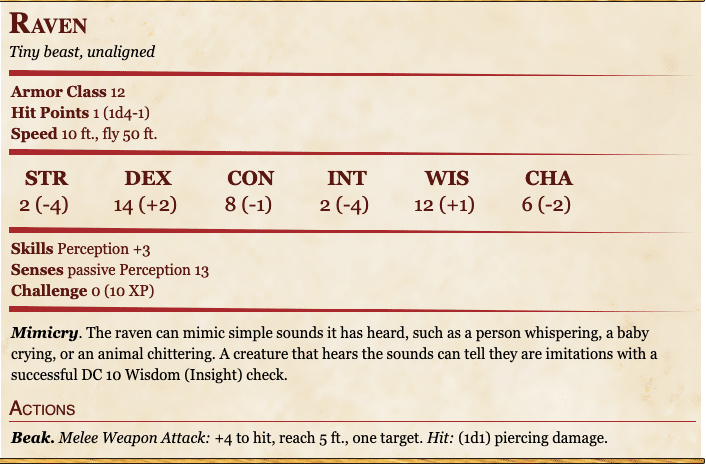
A raven is decent in everything and perfect for those that love tricks. Their “Mimicry” ability is useful for anyone in need of a trick, and with flight and positive stealth and perception checks. It becomes a solid choice for any magic caster with find familiar (Especially those tied to death).
As noted before, the mimicry trait has incredible use much like minor illusion. Being able to deceive enemies into moving to a more advantageous position for you can be extremely strong. Especially when considering minor illusion is limited to 30 feet. A familiar is not. Now it should be mentioned that the raven familiars in 5e only have a DC10 insight check before they realize it is made by something else. While relatively easy to beat, sometimes it does work and when it does it is glorious.
The big downside to these though is that they stand out much like the hawk or bat since ravens are associated with death and graveyards. So, if they do fail their stealth check with their +2, they are definitely going to be either shooed away or killed.
Choosing Your Familiars: Sea Horse (1.5/10)
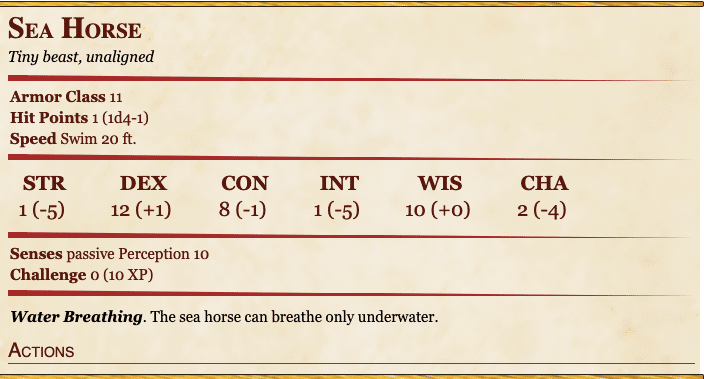
A sea horse while cute and adorable, are terrible familiars in 5e. Like extremely terrible. In fact, the only use I can think of for a sea horse is that they are cute. Everything else just has me thinking, “Why Bother?” Nonetheless, let’s go over why they get a 1.5/10.
I have mentioned numerous times that stealth and perception are the most called for skills among 5e familiars, so what do they have? A +1 to stealth and a flat roll for perception already making them weaker than even the crab since crab familiars get proficiency in stealth.
Meanwhile, relating back to perception, a familiar helps tremendously if they can see outside of normal vision. Yet, they do not get darkvision or blindsense making them weaker than most other aquatic creatures.
Then we get to mobility, vital for keeping your familiar alive. Yet a sea horse only has 20-foot movement speed making them as fast as a lizard but even lizards have additional stuff like a climb speed.
Finally, on top of all that, a sea horse is limited to only being allowed in water. I know it makes the most sense, but still, it puts a hard restriction on top of everything else holding back the seahorse. The only real reason I do not give it a 1.5 is that I am sure there is something cool regarding the sea horse that I just do not know. So, if you can think of something let me know and I will gladly change this rating.
Choosing Your Familiars: Spider (4/10)

I actually like the spider familiars in 5e. Their uses are extremely niche, but they are the only familiars with their abilities and can be really cool.
The first thing to look at is their stealth. Their stealth is rather good with a +4 making them actually a rather decent choice for choosing for stealth. That on top of how often spiders are ignored make them the closest thing to a fly on the wall when needing to listen in on a conversation. This said, if caught they are guaranteed to be squashed because everyone but drow will kill a spider on sight.
They lack mobility which holds them back rather much. In fact, in mobility, they are no better than a lizard meaning they are rather weak when it comes to combat situations. However, their niche abilities are built for utility and not combat.
In regard to utility, their web sense and spider climb make them much more useful than just 30 feet of darkvision. One reason is because spider climb allows you to be out of most people’s peripheral view as very few people look up at the ceiling. Moreover, by being able to walk on ceilings you can travel through cracks in a ceiling or reach points that most other familiars cannot reach.
Combine that with their web sense, and you have a good scout or warning system. An example I like to give is to use the spider familiars in 5e to craft a spider web across a hallway or something similar. Then order your spider to spin a web trail to where they can reach you first or stay with you. When someone cuts it down or walks through boom. Silent alarm goes off as your spider alerts you.
Choose Your 5e Familiars: Weasel (6.5/10)
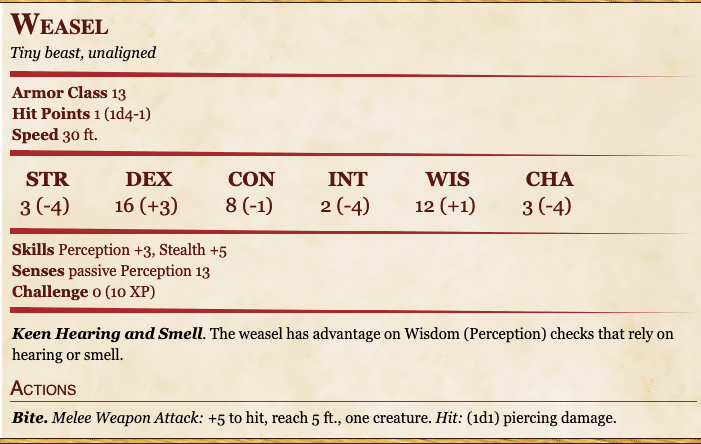
Another favorite of mine, but for sentimental reasons. I actually love this one because of my first familiars for 5e was a squirrel. And to have a squirrel I had to re-flavor a weasel to do it. As such, I got in many shenanigans thanks to him and everyone loved him. That said, I will try to remain unbiased when talking about our last familiar on the wizard list.
A decent perception and solid stealth make them a rather well scout for exploring a new area. Moreover, having advantage on hearing and smell perceptions can be useful in finding anyone invisible.
That said, not much else makes them stand apart. Their skill proficiencies are better than most which are the big reason why they make it above a 5 on the rating. The reason being, everything else is rather standard and even they only have a 30-foot movement and no additional things to increase mobility making them rather average.
Finally, they also suffer from not being something you see every day. Therefore, if you fail your stealth check they are going to notice you and try to get rid of you. Which, in conclusion, makes them a decent choice for anyone for scouting and of course re-skinning another creature. But very little makes them stand out from the crowd.
Familiars in 5e: Conclusion
There’s the review. All 4782 words going into details of what makes each of the familiars stand apart, and what makes them weak or strong. I hope you enjoyed it and if you think you found the spell you want to pursue; then might I suggest some more reading material for you to peruse before making that decision. It is called the “best wizard spells in 5e we don’t think about”. It is an in-depth analysis going over three spells that people do not think of choosing that is really strong and can compete with the obvious choices. They go over one combat, one utility, and one for roleplay. It’s a really good read and one of my most popular articles. Well enough of that, if you are tired of reading then perhaps leave a comment on what you thought about the post. Hope you have a great day!
- P.S. If you enjoyed this post and want to help me out, then please feel out this quick 6 question survey. Thanks!

